
© Ennis Physiotherapy Clinic, 3A Barrack Close, Barrack Street, Ennis, Co. Clare V95 X437 Tel: (065) 6840757
Spinal Problems Neck + Back Pain Disc Injury Whiplash Posture
Lower Limb Injuries Walking + Running Ligament Injury Snowsports Injury Home Exs Prog
Upper Limb Injuries Ligament Sprains Tendon+Muscle Golf + Bike Set Up Useful Links

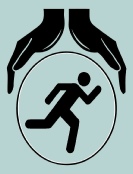


065 6840757

Mon - Fri 9.30am - 8.30pm


3a Barrack Close, Barrack St., Ennis, Co. Clare V95 X437
Key Messages for Fallers
- Exercise to prevent falls should be individually tailored
- Not all types of exercise prevent falls
- Exercise prescription will differ depending on the individuals fitness needs and medical history.
- Exercise to prevent first falls in an older persons could involve balance and strength training
- Exercise should include dynamic balance, strength and functional floor activities, posture + gait training.
- Exercise to manage falls can be home or group based
- Exercise should retrain or maintain the ability to get up from the floor after having fallen.
Falls are preventable. Falls generally are accidental and unplanned (unless you are a stuntman or a goalkeeper!) but the risk of falling can be reduced and minimised.
Every working day seven people are hurt in workplace slips, trips and falls with at least one of those so badly hurt that they miss over a month from work
Slips, trips and falls are the second highest single cause of workplace injuries - there were about 1,700 workplace slips, trips and falls reported to the HSA in 2017 Slips, trips and falls are more likely to lead to significant time off work compared to all other accidents. Females account for a significant percentage of slips, trips and falls victims
Slips, Trips and Falls (STF) were the most common workplace accident type for the Injuries Board. Nearly 50% of all claims made against retailers are slips, trips and falls cases according to Retail Ireland and account for the largest cause of accidents across all sectors according to the European Agency for Safety and Health at Work.
Slips account for about half of all slips, trips and falls but this increases to 80% where floor surfaces are wet, slippery or where cleaning is occurring.
Factors that have been identified in workplace slips, trips and falls include:
- Stairs and steps - descending is a particular concern and can result in more serious injuries.
- Slippery wet surfaces.
- Gender - many victims are female.
- Cleaning is associated with wet floors, trailing cables, obstructed walkways etc Most victims of slip[s, trips + falls due to cleaning are not the cleaners themselves.
- Over-use of signs may be an issue and may themselves be a trip hazard. Signs were present and did not prevent many cleaning slips.
- Footwear
- Vehicles , especially exiting vehicles.
- Ice (and snow) can double the number of slips, trips and falls. Many accidents happened from 6am to 11am.
- Entrances + exits - highest incidence occurs from 8am to 10am. Mats and floor surfaces may be factors too.
Key areas to consider when assessing the risk for slips, trips and falls include
- spills,
- high risk areas,
- over-used warning signs,
- environmental cleanliness and
- shoes
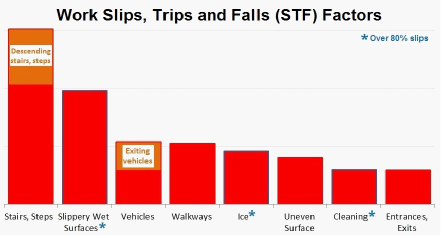
Spills
Spills can occur in every workplace and the resulting wet surface increases the likelihood of a slip or falls occurring. Therefore it is important to have procedures in place to reduce this likelihood.
- Deal with spills straight away
- Consider routine monitoring of areas where spills are a high risk
- Use absorbent material to soak up the spill - identify areas at high spill risk and locate absorbent materials nearby
- Where possible avoid using wet cleaning as this may spread the potential danger area
- Consider using spill kits
- Ensure slip resistant footwear is provided and worn as needed
- Identifying areas where spills may occur and putting controls in place, e.g. proper mats, sufficient drainage, drip trays in anticipation of the spills will also reduce the risk.
- Where there are sources of liquid, e.g. equipment using water/ liquid, wash-up areas, showers, toilets, water dispenser.
- self-service drinks areas.
- Walk-in chiller and freezer floors
- fruit/vegetable items on a floor e.g. tomatoes, grapes, leaves
High Risk Areas
High risk areas need to be identified.
The floor in a workplace must be suitable for the type of work activity that will be taking place on it. Where a floor can't be kept dry, people should be able to walk on the floor without fear of slipping on it. It should have sufficient roughness (slip resistance) and must be fitted correctly.
High risk areas will include transition areas, where pedestrians move between areas of different levels of grip, i.e. from dry to wet surfaces at exits. It is important that:
- Precautions are taken to remove excess moisture from footwear
- Mats provided are properly designed/fitted and secured. Use heavy mats or ones with weighted edges or recess the mats into the floor
- Mats provided are placed where people actually walk
- Areas where levels change, e.g. slopes, ramps, steps/stairs, unexpected holes, bumps, drainage channels, are another high risk area. Controls to be considered include:
- Slip resistant surfaces are provided
- Proper lighting is provided
- Changes in level are highlighted
- Proper drain covers are provided
- The top & bottom of stairs are kept clean & tidy
- Avoidance of carrying items on stairs, e.g. by use of dumb waiters
Damaged flooring is high risk of slips, trips and falls. Identify it and have it repaired. Avoid damage to floors where possible.
Trailing cables and hoses are a trip hazard. Possible control measures include:
- Identify poorly sited gas, liquid supply points and reroute where possible
- Site electrical outlets to avoid trailing cables
- Place equipment close to electrical outlets where possible
- Avoid the use of extension cables if possible
- Use retractable reels
- Where a trailing cable is used temporarily, fix the cable down
Slippery surfaces are also high risk areas. High gloss or highly reflective = high risk.
- Consider changing or treating floor surfaces, e.g. addition of slip resistant materials, etching.
- Consider effect of severe weather - Grit or salt help.
- Ensure slip resistant footwear is provided and worn as needed Back to Top
Over Used Warning Signs
Warning signs do not physically keep people away from wet floors. They will not substitute for protective measures.
During scheduled / routine floor cleaning keep pedestrians away from wet / moist floors by using physical barriers.
Remove when they are no longer applicable.
Environmental Cleanliness
Good housekeeping standards are everyone’s responsibility and may include:
- Ensure the walkways through the workplace are kept clear
- Tidy as you go – not at end of shift / day
- Keep floors & access routes clear
- Keep pedestrians away from messy operations
- Dispose of packing material and other wrappings carefully.
- For routine cleaning:
- Ensure cleaning staff have received proper training and instruction
- Provide cleaning staff with slip resistant footwear and ensure they are worn
- Assess if cleaning is actually required
- Use dry cleaning methods (e.g. a dry microfibre brush) instead of wet cleaning
- Clean floors at times when minimum or no traffic
- Cordon off the floor area being cleaned using a barrier
- Organise a safe pathway through a cleaning area
- Where wet cleaning, use water at the right temperature and with the minimum detergent possible.
- Remove excess water / liquid to assist the floor drying process.
Shoes (Safety Footwear)
Employers should provide personal protective equipment (PPE) footwear if needed at no cost to the employee. Consider the following;
- Good tread pattern and a flexible sole - the more edges, the firmer the grip
- Employees will wear them if they are comfortable + fit well
- Trial the footwear for suitability in your workplace
- Footwear that work in dry conditions may not in wet conditions.
- Sole tread may clog up with debris so keep clear of waste.
- With clogs, ensure an ankle strap is in place and used properly
- Ensure that safety overshoes provide adequate slip resistance
- Check footwear for appropriateness of slip resistance.
- Ease of cleaning and maintenance
- Avoid open shoes, sandals, flip-flops, high heels + smooth soles.
Employer’s Responsibility
Employers have a responsibility to control risks from slips, trips and falls. This includes:
1. Conducting workplace specific slips, trips and falls risk assessment(s)
2. Conducting audits as required to ensure responsibilities are met
3. Providing personal protective equipment (e.g. slip-resistant footwear) if required
4. Ensuring employees receive appropriate training and instructions
Employee’s Responsibility
Employees also have responsibilities in relation to controlling the risk from slips, trips and falls, including:
1. Reporting anything dangerous, e.g. damaged flooring, spills
2. Using and taking proper care of any personal protective equipment, e.g. slip-resistant footwear. Back to Top
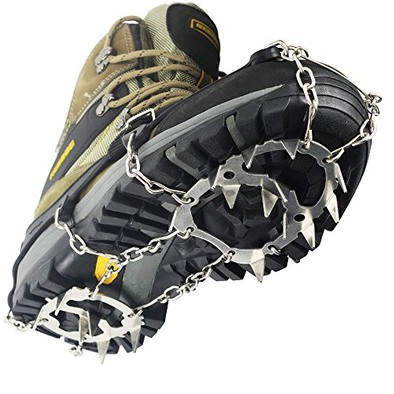
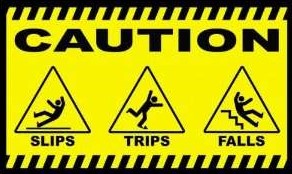
A Fall is a sudden uncontrolled movement causing the body to move downwards to make contact with a lower level or the ground, typically rapidly and without control.
A slip is to lose one's footing (base of support) which causes an unintentionally slide for a short distance. This may result in a fall if the centre of gravity comes outside of the base of support.
A trip is to catch one's foot unexpectedly on something while moving causing one to stumble or fall.

How to Stay Safe + Help Avoiding Falling
It is often suggested that older people should slow down and take things easy. If older people stay active and put their bodies through full ranges of motion they will maintain their joints, muscles and nerves, which enables normal movement to occur.
Exercise will help maintain / improve balance and reduces the risk of falls. Therefore:
- Keep fit! Take up an enjoyable physical activity.
- Speak to a chartered physiotherapist for advice on exercise to improve your strength and balance
- Eat a balanced diet and keep the body hydrated
- Check the slipping / tripping hazards – rugs, mats, obstacles in passage ways, etc.
Dealing with falls
If you or a relative has suffered from repeated falls, speak to a physiotherapist, occupational therapist or GP to discuss having a falls assessment. You can also:
- Get a pendant alarm
- Learn how to get off the floor
- Position cushions and blankets so they can be reached by a fallen person if needed if stuck on the floor until help arrives.
- Carry a cordless or mobile phone around to summon help.
Falls and Frailty in Older People
Many falls do not result in injury but do impact on confidence and increase fear. Many times falls among older people are preventable.
Falls represent over half of all hospital admissions for accidental injury amongst older people
Who is most at risk?
- Frail older people
- Those with long term physical or sensory impairments conditions that affect the body physically – such as stroke, Parkinson’s disease, arthritis, visual impairment - where the reaction to prevent a fall isn’t effective
- Those with mental health / learning disabilities or who are unaware of the risks of falling
How much risk?
.
Any YES answer = increased risk. If there are 3+ YES answers there is a high risk of falling.
- Have you had a history of falling in the past year?
- Are you on four or more prescribed medications?
- Do you have a history of stroke or Parkinson’s disease?
- Have you experienced any problems with balance?
- Are you unable to rise out of a chair without using arms?
Role of Chartered Physiotherapist
If you are worried about falls you should seek advice from a chartered physiotherapist. They can advise on how to keep mobile + flexible and how to prevent a fall.
Physiotherapists can help with advice on:
- Strength
- Co-ordination
- Balance
- Flexibility
- Endurance for physical enhancement
- Confidence
Physiotherapists may assess a home for slipping + tripping hazards and then;-
- Refer to other professionals as appropriate.
- Developing an individualised person centred approach as part of a multi-disciplinary team
- They can also minimise the risk of a ‘long lie’ on the floor by teaching people how to get up
- They can refer to suitable exercise options in the community.
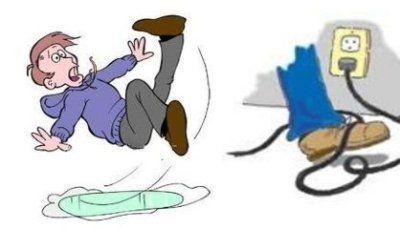

Risk factors that are not not modifiable with exercise include age, gender, chronic medical conditions, + non-correctable vision.
Risk factors that are modifiable include poor balance, fear of falling, low strength and power, poor gait and functional ability, depression and arthritic pain, which may all be helped by exercise.
Many older people do not injure themselves in a fall, but have great difficulty getting up again after the fall, thus remaining on the floor for some time - ‘a long lie’. Shock, injury, fear of further damage to the body by trying to move and a lack of physical fitness or knowledge how to get up may be important causes of remaining on the floor. Training on how to get up from the floor may be very useful for those who have fallen, and indeed for those at risk of falling for the first time.
For those who have not yet fallen, there are many more vigorous exercise programmes that may be appropriate – like Tai Chi, dancing and bowls.
A Falls Exercise Programme should (re)train the ability to get up from the floor. It should also practice other skills such as crawling + rolling, summoning help and keeping warm while on the floor.